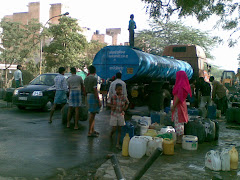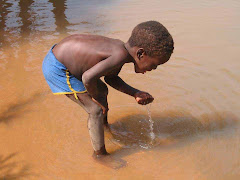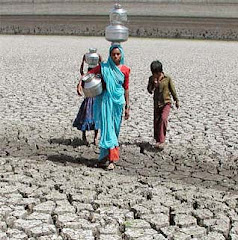Several of the world's largest corporations, some with operations spanning several countries, have been urged to disclose their complete water usage and participate in the first voluntary water-disclosure exercise being undertaken at a global scale by London-based investor-backed non-profit organization Carbon Disclosure Project (CDP).
The CDP issued the first of its kind water-disclosure questionnaire last week in London and began a campaign that seeks to put water consumption on par with carbon emissions as a concern of company shareholders. The organization had scheduled for release of the questionnaire around this time when it launched the initiaitve around November last year.
The exercise is purely voluntary and those who have been approached may not respond. But, they are being encouraged by a pool of investors that brings with it formidable wealth, to do so. The investors represent some $16000 billion worth of assets between themselves.
The initiative comes against a backdrop of declining global water availability creating an immense challenge for companies, and a demand for increasing accountability on usage of the fast depleting resource. In fact, several reports have highlighted that poor water availability as well as an increase in its procurement cost is emerging a formidable business risk.
Several projections point out that in several areas across the world, water may not just be available to run business operations in the not so distant future. At the same time, experts have been issuing stern warnings that companies, and their investors, should start to appreciate the new category of risk to their future businesses -- running out of water.
Projects like CDP's not only manage to create awareness and help businesses and institutional investors understand the risks and opportunities associated with water scarcity and other water-related issues, but at the same time, give a unstated warning to most companies operating in water-intensive sectors.
The 302 companies asked to send in their responses by July-end include the who's who of the global business world -- ABB, Nokia, Intel, Procter & Gamble, Bayer, Boeing, Cadbury, Carrefour, Christian Dior, Danone, IBM, Johnson & Johnson, Coca-Cola, Nestle, Unilever, PepsiCo, McDonald's, Nike, Novartis, Sony Corporation, Yum Brands, among others.
Ford, PepsiCo, Molson Coors, L’Oréal and Reed Elsevier, some of whom are involved in the project in various capacities, are among those who have already accepted to respond.
Indian companies that have been sent the questionnaire are Bharat Heavy Electricals LTD (BHEL), Indian Oil, ITC, Larsen & Toubro, NTPC, ONGC, Reliance Industries, Steel Authority of India Ltd (SAIL). There is also Arcelor Mittal, the global steel giant of India-born LN Mittal.
The questionnaire asks the respondents to spell out if they have a water policy, strategy or management plan. And, if they have one, then it asks comanies to describe it.
It also asks respondents to identify the percentage of their operations in the world’s water-stressed areas and what portion of their water use comes from these regions. It asks companies to spell out their water use, recycling and discharges into or near wildlife habitats as well as list water-related risks and opportunities.
Basically, companies are being asked for details of their water footprint and also make a disclosure that they are maintaining stewardship on this count.
Companies that choose to respond to the questions have the option of making their answers available only to these investors, or to the larger public as well. Also, companies that have not been sent the questionnaire can also respond to it, if they want.
As human population growth and climate change exacerbate water shortages worldwide, such efforts will go a long way to ensure that water management remains tight, and companies and people remain accountable for their water usage.
Friday, April 23, 2010
Wednesday, April 14, 2010
Asian tree to provide low-cost water purification method
As water pollution continues to play havoc with the world's dwindling water supplies, the search for innovative and low-cost purification technologies continues.
Some Canadian researchers have come across a tree found in several parts of Asia that could also provide another low-cost water purification technique to help bring down the incidence of waterborne disease in the developing world. This could be welcome news for Asia, as along with Africa, it remains one of the largest areas where water scarcity and pollution run hand-in-hand.
If one adds some parts of Latam (Latin America), then over a billion people reportedly rely on untreated surface water sources for their daily water needs. Reports suggest that almost two million die from diseases from contaminated water every year. Children under five years of age account for the largest number of deaths.
According to the researchers, a simple procedure that uses seeds from the Moringa oleifera tree can produce upto 99.99 per cent bacterial reduction in previously untreated water.
The seeds can be crushed into powder and used as a water-soluble extract in suspension, which creates an effective natural clarification agent for highly turbid and untreated pathogenic surface water.
The technique improves drinkability and reduces water turbidity (cloudiness), thus making water microbiologically and aesthetically acceptable for human consumption.
Some Canadian researchers have come across a tree found in several parts of Asia that could also provide another low-cost water purification technique to help bring down the incidence of waterborne disease in the developing world. This could be welcome news for Asia, as along with Africa, it remains one of the largest areas where water scarcity and pollution run hand-in-hand.
If one adds some parts of Latam (Latin America), then over a billion people reportedly rely on untreated surface water sources for their daily water needs. Reports suggest that almost two million die from diseases from contaminated water every year. Children under five years of age account for the largest number of deaths.
According to the researchers, a simple procedure that uses seeds from the Moringa oleifera tree can produce upto 99.99 per cent bacterial reduction in previously untreated water.
The seeds can be crushed into powder and used as a water-soluble extract in suspension, which creates an effective natural clarification agent for highly turbid and untreated pathogenic surface water.
The technique improves drinkability and reduces water turbidity (cloudiness), thus making water microbiologically and aesthetically acceptable for human consumption.
Monday, April 5, 2010
PepsiCo to provide water to 3 million people by 2015
Cola major PepsiCo has unveiled global plans to provide access to safe water to three million people in developing countries by 2015. The company has also announced plans to bring down its water consumption in production.
PepsiCo announced recently that it would continue to make efforts to arrive at positive water balance in its operations in water-distressed areas.
It will be a welcome step as the company, along with its main rival Coca Cola, has often been accused of exploitation of water resources around some of its manufacturing plants. The two cola majors have been under intense pressure in India, where they have both been separately announcing plans to arrive at a positive water balance -- recharging water levels in areas where their plants have become controversial as much as they have been taking from the soil.
The company said during 2011, the PepsiCo Foundation will reach its goal of providing access to safe water and sanitation to 1 million people through support of several partners. It has been working with several partners, spread across countries, in projects that seek to enhance access to water and sanitation facilities to local communities.
A statement issued by the company said it had set a global goal in 2007 to reduce water consumption by 20 per cent per unit of production by 2015. To date, the company has achieved a more than 15 per cent improvement in water use efficiency as compared to the company's 2006 baseline, it added.
Some of its global partners include Water.org, Safe Water Network, The Energy Resources Institute, China Women's Development Foundation and the Earth Institute at Columbia University. Together, they have been helping install village water and irrigation systems, establishing water health centers, constructing rainwater harvesting cisterns, improve sanitation programs and recharge aquifers in developing communities, particularly in Ghana, Kenya, Brazil, China and India.
The announcements by the company come against a backdrop of increased focus of corporate role in sustainable development. Companies are now being held accountable for mismanagement of water resources, particularly in water-starved regions.
PepsiCo announced recently that it would continue to make efforts to arrive at positive water balance in its operations in water-distressed areas.
It will be a welcome step as the company, along with its main rival Coca Cola, has often been accused of exploitation of water resources around some of its manufacturing plants. The two cola majors have been under intense pressure in India, where they have both been separately announcing plans to arrive at a positive water balance -- recharging water levels in areas where their plants have become controversial as much as they have been taking from the soil.
The company said during 2011, the PepsiCo Foundation will reach its goal of providing access to safe water and sanitation to 1 million people through support of several partners. It has been working with several partners, spread across countries, in projects that seek to enhance access to water and sanitation facilities to local communities.
A statement issued by the company said it had set a global goal in 2007 to reduce water consumption by 20 per cent per unit of production by 2015. To date, the company has achieved a more than 15 per cent improvement in water use efficiency as compared to the company's 2006 baseline, it added.
Some of its global partners include Water.org, Safe Water Network, The Energy Resources Institute, China Women's Development Foundation and the Earth Institute at Columbia University. Together, they have been helping install village water and irrigation systems, establishing water health centers, constructing rainwater harvesting cisterns, improve sanitation programs and recharge aquifers in developing communities, particularly in Ghana, Kenya, Brazil, China and India.
The announcements by the company come against a backdrop of increased focus of corporate role in sustainable development. Companies are now being held accountable for mismanagement of water resources, particularly in water-starved regions.
Thursday, April 1, 2010
India launches Web-enabled groundwater information system
The Indian government has launched a Web-enabled information system that will allow all stakeholders to access information about groundwater availability acrosss the country seamlessly.
The system was jointly developed by Central Ground Water Board (CGWB), which is under the administrative control of the Water Resources Ministry, and the National Informatics Centre (NIC).
Launching the system on World Water Day on March 22, India's Union Minister for Water Resources Pawan Kumar Bansal said the system would provide all the stakeholders access to various thematic layers as well as the nationwide database generated by CGWB on groundwater level and water quality.
The initiative would help more effective sharing of information relating to groundwater resource availability and water level trend with user groups, planners and administrators, he added.
The Online system comes at a time when India's groundwater resources are dwindling at a fast pace. In several blocks across the country, the rate of extraction of groundwater is increasing and exceeds the rate of recharge, leading to lowered water tables. Experts have cautioned that over-exploitation of aquifers is also likely to hit the fragile ecosystems.
Bansal urged all Federal and state government departments which are repositories of groundwater data to come forward to pool it on the Web-based knowledge platform for the benefit of all stakeholders.
The system would initially be available in Government-to-Government (G2G) domain for planning and decision-making for management of groundwater resources. later on, the system will allow groundwater information availability to people and all organizations. It would allow, for instance, a farmer to access groundwater information for his village through the e-kiosks that are being set up across the country.
Groundwater remains India’s water lifeline and well over 85 per cent of rural water supply comes from it. Also, as much as half of the urban and industrial water supply too comes from groundwater systems.
The Indian Government has been making efforts to strengthen groundwater resource management system in the country and had in late 2008 announced the launch of a new scheme -- Ground Water Management and Regulation -- after merging three existing ones into a comprehensive one. The scheme, which had an outlay of Rs 460 crore, was also expected to help in delineating groundwater development worthy areas and developing area specific artificial recharge and rain water harvesting techniques.
The system was jointly developed by Central Ground Water Board (CGWB), which is under the administrative control of the Water Resources Ministry, and the National Informatics Centre (NIC).
Launching the system on World Water Day on March 22, India's Union Minister for Water Resources Pawan Kumar Bansal said the system would provide all the stakeholders access to various thematic layers as well as the nationwide database generated by CGWB on groundwater level and water quality.
The initiative would help more effective sharing of information relating to groundwater resource availability and water level trend with user groups, planners and administrators, he added.
The Online system comes at a time when India's groundwater resources are dwindling at a fast pace. In several blocks across the country, the rate of extraction of groundwater is increasing and exceeds the rate of recharge, leading to lowered water tables. Experts have cautioned that over-exploitation of aquifers is also likely to hit the fragile ecosystems.
Bansal urged all Federal and state government departments which are repositories of groundwater data to come forward to pool it on the Web-based knowledge platform for the benefit of all stakeholders.
The system would initially be available in Government-to-Government (G2G) domain for planning and decision-making for management of groundwater resources. later on, the system will allow groundwater information availability to people and all organizations. It would allow, for instance, a farmer to access groundwater information for his village through the e-kiosks that are being set up across the country.
Groundwater remains India’s water lifeline and well over 85 per cent of rural water supply comes from it. Also, as much as half of the urban and industrial water supply too comes from groundwater systems.
The Indian Government has been making efforts to strengthen groundwater resource management system in the country and had in late 2008 announced the launch of a new scheme -- Ground Water Management and Regulation -- after merging three existing ones into a comprehensive one. The scheme, which had an outlay of Rs 460 crore, was also expected to help in delineating groundwater development worthy areas and developing area specific artificial recharge and rain water harvesting techniques.
Subscribe to:
Posts (Atom)

.jpg)


